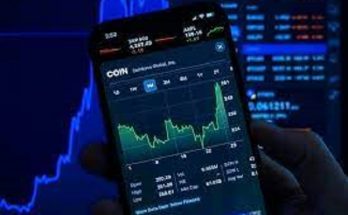In the ever-evolving world of trading, trends come and go—but a few indicators have stood the test of time. With AI algorithms and market manipulation growing more sophisticated, most traditional indicators now fail to provide reliable signals. Yet, in 2025, a few still work—and work exceptionally well. Whether you’re an intraday trader, swing trader, or investor, understanding these indicators can elevate your strategy and performance.
1. Volume Profile: The Institutional Footprint
What Is Volume Profile – and Why It’s Not Just “Volume”
Most traders are familiar with volume bars that appear at the bottom of the chart. But Volume Profile is a more sophisticated, institution-level tool.
It displays volume on the price axis instead of the time axis.
This means:
- You’re not just seeing how much volume happened,
- But also at what price levels it was transacted.
Think of it like a heat map for smart money.
Core Components of Volume Profile
1. Point of Control (POC)
The price level with the highest traded volume during a given session or range.
- Price often gravitates toward this level
- Acts like a magnet during consolidation phases.
In 2025, algorithms use POC to test conviction before a breakout or breakdown.
2. High Volume Nodes (HVNs)
Price levels where large volumes were traded.
- Often become strong support or resistance.
- Indicate acceptance zones—where institutions have agreed on value.
These zones are rarely breached without strong catalysts, and often see price reacting sharply when revisited.
3. Low Volume Nodes (LVNs)
Areas with very little volume.
- Indicate rejection zones.
- Act like fast lanes for price—these are often breakout or breakdown levels.
Many fake breakouts happen near LVNs. But when Volume Profile is used smartly, traders can see through the trap.
Why Volume Profile Still Works in 2025 – Even When Everything Else Fails
- Smart Money Doesn’t Hide Volume
Institutions leave behind clear volume footprints when placing large buy or sell orders. Volume Profile doesn’t just spot these footprints—it helps decode their intent. - Market Structure Is Volume-Driven
All price action is ultimately volume-based. Whether you’re trading SMC, ICT concepts, or basic breakout setups, volume context separates smart trades from guesswork. - Works Across Timeframes
- Intraday traders use 1-day Volume Profile to scalp off HVNs/LVNs.
- Swing traders rely on multi-day profiles to plan reversals and continuations.
- Investors track macro POCs over months for accumulation zones.
How to Use Volume Profile in a Real Setup (Nifty Example)
Let’s say Nifty is trading around 19,850.
- You see a POC at 19,800, which price tested twice and bounced.
- You identify a LVN near 19,930, which has never seen strong volume.
- Price consolidates near 19,870 with declining volume.
What This Tells You:
- The 19,800 zone is a battle-tested base—buyers are strong here.
- 19,930 is a low-volume trap—if price reaches there quickly, it’s likely to break out or reject sharply.
- You set up a long entry near 19,810 with a tight SL, targeting LVN break at 19,930.
This is not speculation—it’s volume-verified probability.
Common Mistakes When Using Volume Profile
- Ignoring Context: Never use Volume Profile alone. Always combine it with price structure, RSI, or Order Flow.
- Assuming All HVNs Are Strong: Some are part of distribution, not accumulation. Learn to distinguish.
- Using Wrong Session Settings: Use the right range—a day profile for intraday, weekly/monthly for swing/investing.
Pro Tips for 2025 Traders
- Use Session Volume Profile for intraday scalping.
- Combine Volume Profile + Order Flow for breakout trades.
- Mark composite HVNs and LVNs on your charts as key zones for reversals or continuations.
- Always ask: Where would smart money enter or exit?
Final Word on Volume Profile
In a market dominated by liquidity algorithms and institutional traps, traders who can read volume footprints are 5 steps ahead. Volume Profile is not a “fancy indicator”—it’s a window into market truth.
If you use it right, it can:
- Sharpen your entries
- Improve your risk-reward
- Help you think like an institution
And that’s why Volume Profile remains one of the top 3 trading indicators that still work in 2025.
When used with other tools like Order Flow or RSI divergence, Volume Profile becomes a blueprint for high-probability trades. If you’re looking to master this with real-time mentorship, check out our advanced trading courses on Smart Money Concepts and live trading.
2. Relative Strength Index (RSI): Reinvented, Not Replaced
What Is RSI – Beyond the Basics
The Relative Strength Index (RSI) is a momentum oscillator ranging between 0–100 that measures the speed and magnitude of recent price changes.
Traditionally:
- Above 70 = Overbought → Potential reversal
- Below 30 = Oversold → Potential bounce
But in 2025, using RSI like it’s 2010 simply doesn’t work anymore.
Why? Because markets are now faster, smarter, and full of traps.
The real power of RSI lies in how you adapt it.
The Evolution of RSI – What’s New in 2025?
1. Dynamic RSI Zones (Not Static 70/30)
In today’s volatile markets, static thresholds no longer give reliable signals.
- On trending stocks or indices like Nifty, RSI can hover above 70 for days without reversing.
- On sideways setups, it may bounce between 40–60 constantly, giving false reversal signals.
How to fix it:
- Use 65–85 for overbought zones in strong uptrends.
- Use 15–35 for oversold zones in strong downtrends.
- Let RSI adapt based on ATR (Average True Range) or Volatility Index (VIX).
This keeps your strategy aligned with market context, not outdated rules.
2. RSI + Trend Filter = More Accuracy
One of the biggest mistakes is using RSI without filtering the trend.
In 2025, combine RSI with a moving average, such as:
- RSI + 21 EMA: Only take RSI oversold signals if price is above EMA (i.e., in uptrend).
- RSI + SuperTrend Indicator: Only act on RSI divergence when SuperTrend is green/red accordingly.
This filter eliminates 70% of fake signals.
3. RSI Divergence + Volume Confirmation = Smart Money Setup
Divergence is when price makes a higher high, but RSI makes a lower high (or vice versa).
But most retail traders miss this:
- Divergence without volume confirmation is useless.
- Hidden divergence, especially when backed by volume or order flow data, is what institutions act on.
How to use it:
- Long Setup: Price makes higher low, RSI makes lower low = Hidden Bullish Divergence
- Short Setup: Price makes lower high, RSI makes higher high = Hidden Bearish Divergence
Now add Volume Profile or Order Flow confirmation = You have a high-probability reversal zone.
Real Example (Nifty or BankNifty)
Let’s say:
- Nifty hits a price of 19,930 with RSI at 76.
- Two sessions later, price goes to 19,970, but RSI drops to 70.
- Meanwhile, Order Flow shows exhaustion and low buying volume.
- This is a Bearish RSI Divergence, backed by real-time data.
- Smart Money is distributing, not pushing price higher.
- That’s your short setup, not a reason to chase longs.
This is how RSI is used by institutional-grade traders in 2025.
Common RSI Mistakes That Traders Still Make
- Using fixed 70/30 levels in all conditions
- Acting on RSI without any trend context
- Taking every RSI crossover as a signal
- Ignoring divergence or not combining it with volume/order flow
RSI Works Best When It’s a Part of a Bigger Picture
Use RSI as a filter, not a standalone entry tool. Some practical combos in 2025:
| Strategy | Tools Used | Application |
| RSI + EMA | Trend Confirmation | Only trade pullbacks in the direction of trend |
| RSI + Volume Profile | Entry Timing | Find reversals at HVNs/LVNs |
| RSI + Order Flow | Smart Confirmation | Confirm divergence or entry zone |
| RSI + SMC Concepts | Institutional Alignment | Trade away from liquidity traps |
Final Word on RSI in 2025
If you’re using RSI in its default form, you’re at the mercy of the market.
But if you:
- Let RSI breathe with volatility
- Combine it with trend filters
- Use divergence with real confirmation tools
Then RSI transforms from a basic oscillator to an institution-level edge.
It’s not about throwing away indicators. It’s about using them intelligently in the new age of trading.
- That’s why RSI is still one of the most reliable trading indicators that work in 2025—not because it stayed the same, but because it evolved with the market.
3. Order Flow Analysis: The Real-Time Edge Every Serious Trader Needs
What Is Order Flow?
Order Flow is the live reading of buy and sell transactions as they happen in the market. It shows you who is in control—buyers or sellers—right now. Unlike indicators based on past price (like moving averages), Order Flow is:
- Immediate
- Raw
- Unfiltered
It doesn’t guess what might happen. It shows you what is happening.
Core Components of Order Flow
To use Order Flow in 2025 effectively, traders rely on 3 key tools:
1. Footprint Charts
A candlestick chart enhanced with:
- Volume at each price level
- Buy/sell imbalance
- Aggressive vs passive orders
This helps you see inside each candle.
2. Delta (Net Aggression)
Delta = Buy Market Orders – Sell Market Orders
This tells you:
- Who’s pushing the price?
- Are buyers strong, or are sellers absorbing them?
Example:
If price is going up, but Delta is negative, sellers are absorbing = Trap forming.
3. Depth of Market (DOM)
Live visualization of:
- Pending buy/sell orders at each price level
- Spoofing attempts
- Sudden liquidity shifts
Used by scalpers and institutions to:
- Detect large players
- Avoid fake breakouts
- Spot liquidity grabs
Why Order Flow Works in 2025 When Others Don’t
1. It’s Real-Time. Period.
No lag, no delay, no smoothing. You’re seeing live market aggression.
2. Works With Any Asset & Timeframe
Be it Nifty Futures, Bank Nifty, Gold, or Crypto—Order Flow is universal.
Used by scalpers in 1-minute charts and by swing traders to confirm entry zones.
3. It Exposes the Truth Behind Candles
Two candles may look the same on a price chart.
But when you look at their order flow, you’ll know which one is genuine and which one is a trap.
How to Use Order Flow for Better Trades (Example)
Scenario: Nifty approaching resistance at 20,050
- Volume Profile shows LVN at 20,040 (potential breakout level)
- RSI shows bullish divergence at 19,980
- You open Footprint Chart on a 5-min timeframe
And you see:
- Strong delta spike (buyers hitting market orders aggressively)
- But sellers sitting at 20,050 with 4x the size (absorption)
- Delta turns red despite green candle
- This is a fake breakout in progress.
- Big sellers are offloading to retail buyers.
- You prepare to short when price fails to break above with confirmation.
This is institutional-level insight—and it’s only possible with Order Flow.
What You Can Detect With Order Flow in 2025
| Behavior | What You See | Action |
| Absorption | Price stagnant, volume building, delta divergence | Wait or fade move |
| Breakout Strength | Strong delta, follow-through in price | Enter with trend |
| Spoofing | Large fake orders that vanish before fill | Avoid traps |
| Exhaustion | Low delta, low volume near key level | Exit or reverse |
Most Common Mistakes with Order Flow
- Thinking it’s a plug-and-play indicator
It’s a skill, not a shortcut. You need to read and interpret live data. - Only watching candles and ignoring footprint/delta
Candles lie. Order flow reveals intention. - Not combining it with levels like Volume Profile or SMC zones
Best used at critical levels—not mid-range.
Pro Setup: Combine Order Flow With Volume Profile
- Use Volume Profile to mark HVNs and LVNs
- Wait for price to reach those zones
- Use Order Flow (Footprint + Delta) to confirm:
- Is the breakout real?
- Is there aggressive buying?
- Is someone absorbing?
This gives you the highest conviction trades.
Final Word on Order Flow in 2025
Order Flow is not new. But in 2025, with algo-driven manipulation and speed-of-light execution, it has become essential.
While most indicators show what has happened, Order Flow shows what’s happening now.
If you want to:
- Trade like an institution
- Avoid retail traps
- Confirm your levels with data, not hope
Then Order Flow Analysis is non-negotiable.
- That’s why it’s part of the top 3 trading indicators that still work in 2025.
- And that’s why pros never trade without it.
Combining the 3: The Ultimate Trading Edge
While each of these trading indicators that work in 2025 stands strong individually, their combined usage offers exponential value. Imagine this scenario:
- Volume Profile reveals a high-volume node at ₹19,800 in Nifty.
- RSI shows hidden bullish divergence near the same level.
- Order Flow reveals large buy absorption on the DOM.
That’s a confluence trade—one with high conviction and smart risk-reward. It eliminates guesswork and allows a trader to enter based on logic, not emotion.
- These 3 trading indicators are not meant to give a signal every 5 minutes.
- They help you prepare high-quality trades with institutional backing.
- Used together, they transform your screen time from reactive to predictive.
Why Most Indicators Don’t Work Anymore
The landscape of financial markets in 2025 is radically different from what it was just a few years ago. The explosion of high-frequency trading, institutional algorithmic strategies, machine learning models, and liquidity fragmentation has rendered many traditional technical indicators ineffective—especially when used in isolation.
While retail traders continue to rely on tools like MACD crossovers, Bollinger Bands, or stochastic oscillators, professional traders and institutions have moved far beyond. The result? A growing performance gap between traders who evolve and those who don’t.
Thousands of indicators exist. But most are lagging, signal too late, or are easily manipulated by algos.
Here’s why many have stopped working:
- Too simplistic: Relying only on crossovers or trendlines is outdated.
- No volume context: Without knowing who is behind a move, the signal is meaningless.
- Easily faked: Algos know how to create false breakouts and bait retail traders.
That’s why these 3 trading indicators that still work in 2025 are built on real data—not assumptions.
Final Thoughts: Trade Smart in 2025
If you’re still relying on MACD crossovers or stochastic oscillators without volume or order flow validation, you’re trading with a blindfold. The market in 2025 rewards precision, preparation, and patience.
The only trading indicators that still work in 2025 are the ones that align with institutional behavior and modern price action mechanics. For more insights, tools, and community support, visit India’s leading stock market education platform.
Here’s what you should do:
- Learn to read Volume Profile like a map
- Adapt RSI to current market dynamics
- Use Order Flow to see real-time conviction
Embrace these tools, practice them deeply, and your strategy will no longer be reactive—it will be predictive.



